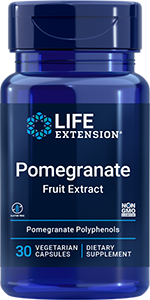- Science & Research
- Science News
- Newsletter
- 2006
- November 28

Newsletter
Newsletter
Another cancer linked with reduced vitamin D levels
 | ||||||||||||||||||||||||||||||
| ||||||||||||||||||||||||||||||
| ||||||||||||||||||||||||||||||
| Life Extension Update Exclusive Another cancer linked with reduced vitamin D levels Readers of Life Extension Update will recall the September 23, 2006 issue which discussed the finding of researchers from the Moore’s Cancer Center at the University of California, San Diego of an association between reduced sunlight exposure and a greater incidence of kidney cancer. Now, in an article that will be published online in the American Journal of Preventive Medicine, the UCSD team reports that women exposed to a greater amount of sunlight, particularly ultraviolet B (UVB) radiation, have a lower incidence of ovarian cancer. UVB exposure stimulates the synthesis of vitamin D in the body, however, the vitamin is also obtainable via the diet and/or supplementation. UCSD School of Medicine professor of Family and Preventive Medicine Cedric F. Garland, Dr PH, and colleagues utilized a database of cancer incidence, mortality, and prevalence in 175 countries, recently made available from the World Health Organization’s International Agency for Research on Cancer. By graphing ovarian cancer incidence rates according to latitude, the team was able to demonstrate an association between higher latitudes, which receive reduced sunlight, and ovarian cancer. Additionally, greater fertility rates among women between the ages of 15 and 19, which may be protective against ovarian cancer, were more prevalent in lower latitudes. “In general, ovarian cancer incidence was highest at the highest latitudes in both hemispheres,” Dr Garland stated. “They were about five times higher in high latitudes, like Iceland and Norway, than in equatorial regions like Asia, South America and Africa. Even after controlling for fertility, the association remained strong.” “Unlike breast cancer, we have no widely accepted means of early detection or prevention for ovarian cancer,” Dr Garland observed. “This new global study shows a link between deficiency of vitamin D and increased incidence of ovarian cancer, suggesting that vitamin D supplementation may reduce the incidence of this aggressive cancer.” Approximately 15,300 deaths from ovarian cancer occur in the United States each year. Evidence points to a prostate, breast, and colon cancer belt in the United States, which lies in northern latitudes under more cloud cover than other regions (Studzinski et al. 1995). Certain regions in the United States, such as the San Joaquin Valley cities and Tucson, AZ; Phoenix, AZ; Albuquerque, NM; El Paso, TX; Miami, FL; Jacksonville, FL; Tampa, FL; and Orlando, FL; have a lower incidence of breast and bowel cancers. Conversely, New York; Chicago; Boston; Philadelphia; New Haven, CT; Pittsburgh; and Cleveland, OH; have the highest rates of breast and intestinal cancer of the 29 major cites in the United States. The greater hours of year-round sunlight correlate to a lower rate of breast and intestinal cancer in the U.S.A. Vitamin D is formed in the skin of animals and humans by the action of shortwave UV light, the so-called fast-tanning sunrays. Precursors of vitamin D in the skin are converted into cholecalciferol, a weak form of vitamin D3, which is then transported to the liver and kidneys where enzymes convert it to 1,25-dihydroxycholecalciferol, the more potent form of vitamin D3 (Sardi 2000). Although vitamin D exists in two molecular forms, vitamin D3 (cholecalciferol) found in animal skin and vitamin D2 (ergocalciferol) found in yeast, vitamin D3 is believed to exhibit more potent cancer-inhibiting properties and is therefore the preferred form. Dark-skinned people require more sun exposure to produce vitamin D because the thickness of the skin layer (the stratum corneum) affects the absorption of UV radiation. Black human skin is thicker than white skin and thus transmits only about 40% of the UV rays needed for vitamin D production. Darkly pigmented individuals who live in sunny equatorial climates experience a higher mortality rate from breast and prostate cancer when they move to geographic areas that are deprived of sunlight exposure in winter months (Angwafo 1998; Sardi 2000). https://www.lifeextension.com/https://www.lifeextension.com/protocols/cancer/cancer-adjuvant-therapy Featured Products
Life Extension Magazine Super Sale Edition, Winter 2006/2007 Reverse atherosclerosis while protecting against cancer Numerous studies show that pomegranate is nature’s most powerful antioxidant. The remarkable effect of pomegranate against various human disorders, however, makes one question whether there is more to this fruit than just its free radical suppressing effects. One answer to this question may lie in the fact that pomegranate is absorbed into the bloodstream far more efficiently than other fruit extracts. One study showed a pomegranate extract to be 95% absorbed, which is far greater than any polyphenol-containing fruit extract of its kind. Another reason that pomegranate has displayed such incredible clinical findings is that it contains a unique polyphenol group called punicalagins. Not only do punicalagins display potent antioxidant effects, but they also interfere with growth factors needed by cancer cells to propagate. By down-regulating these pathological growth factors, punicalagins have been shown to induce the destruction (apoptosis) of common cancer cells. https://www.lifeextension.com/magazine/mag2006/ss2006_report_athero_01.htm | ||||||||||||||||||||||||||||||
If you have questions or comments concerning this issue or past issues of Life Extension Update, send them to ddye@lifeextension.com or call 1-800-678-8989. For longer life,  Dayna Dye Sign up for Life Extension Update at https://mycart.lifeextension.com/Memberships/NewsSubscription.aspx Help spread the good news about living longer and healthier. Forward this email to a friend! View previous issues of Life Extension Update in the Newsletter Archive. | ||||||||||||||||||||||||||||||
The latest news on aging, nutrition, and vitamins
Lab
Testing
How Life Extension lab testing works


